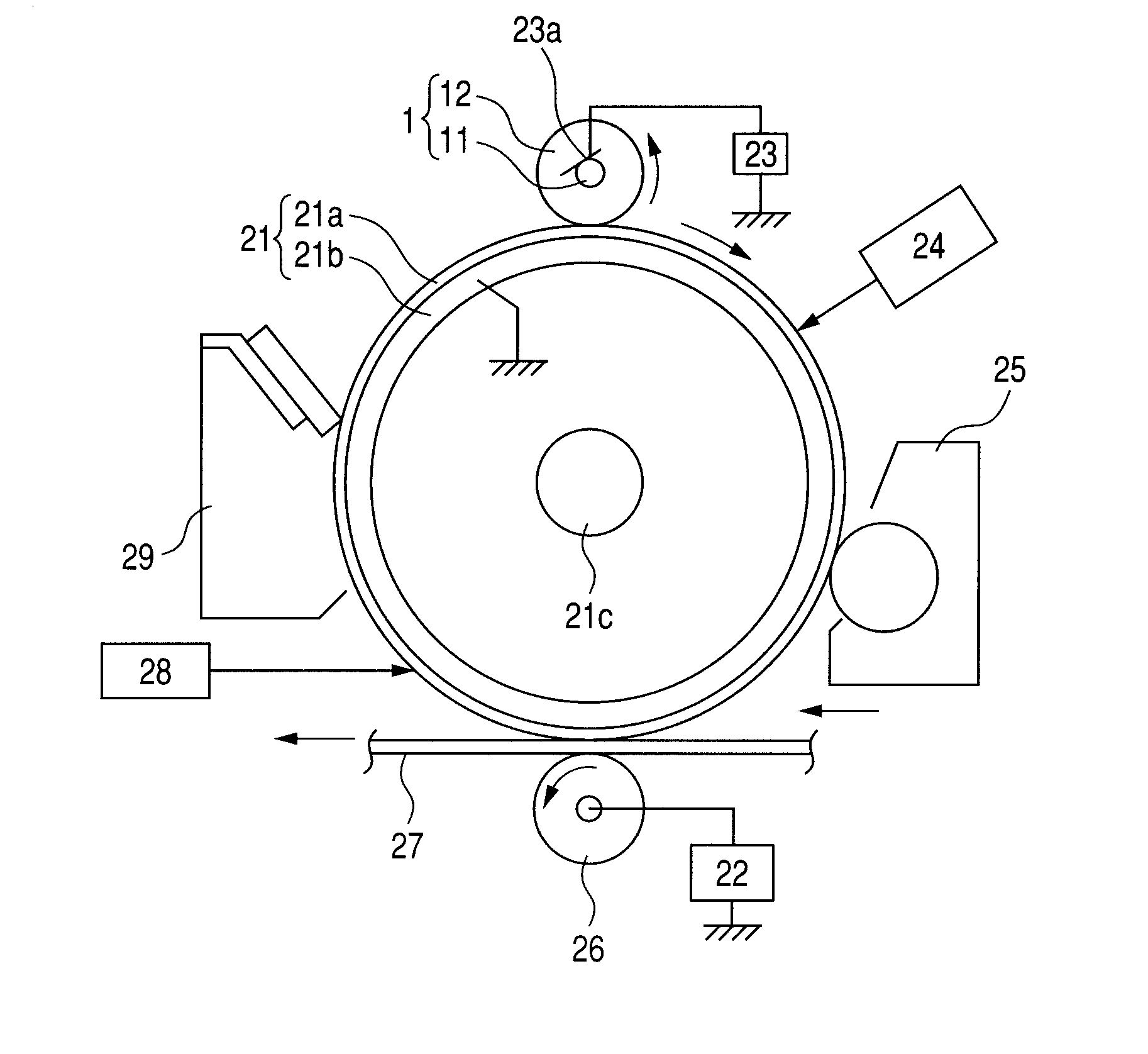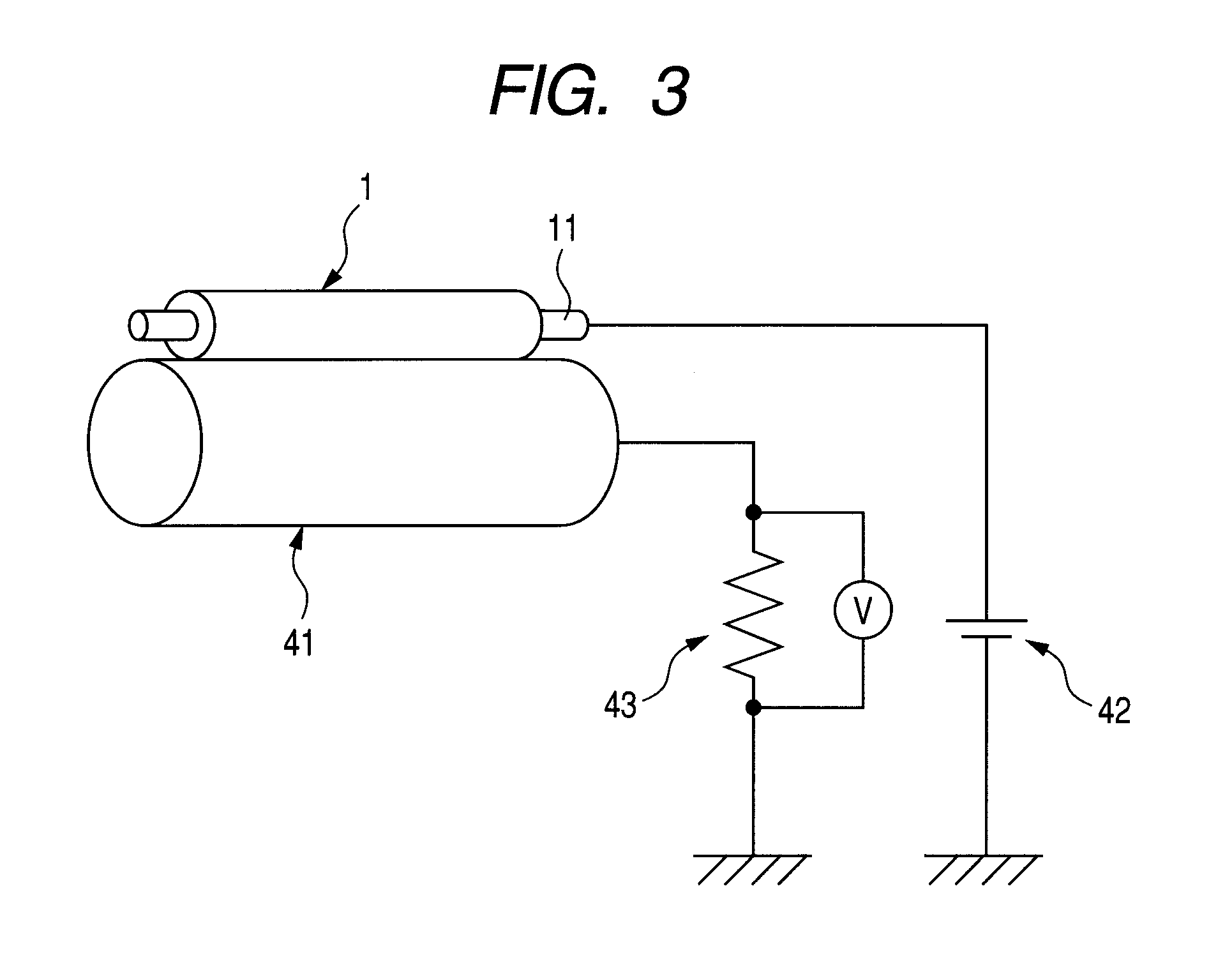Charging member and electrophotographic apparatus
a charging member and electrophotographic technology, applied in the direction of electrographic process, discharge of corona, instruments, etc., can solve the problems of large non-uniformity in the charging roller and electric resistance, and achieve better restraint of charging performance, stable high-grade electrophotographic images, and change over time
- Summary
- Abstract
- Description
- Claims
- Application Information
AI Technical Summary
Benefits of technology
Problems solved by technology
Method used
Image
Examples
example 1
Preparation of Unvulcanized Rubber Composition
[0076]The following materials were mixed by means of a 3-liter pressure kneader for 16 minutes in a packing of 65 vol. % and at a number of blade revolutions of 30 rpm to obtain an unvulcanized rubber composition.
Terminal-modified SBR-1 (binder polymer) 100 parts
Zinc stearate (aid agent for processing) 1 part
Zinc oxide (vulcanization accelerator activator) 5 parts
Carbon black (electrically conductive particles) 50 parts
(trade name: TOKA BLACK #7400F: pH: 7.0; volatile component: 1.5 wt. %; available from Tokai Carbon Co., Ltd.)
[0077]Into 156 parts of this unvulcanized rubber composition, the following materials were mixed by means of an open roll of 12 inches in roll diameter, for 20 minutes at a number of front-roll revolutions of 8 rpm and a number of back-roll revolutions of 10 rpm and at a roll gap of 2 mm to obtain an unvulcanized rubber composition for elastic-material layer.
Sulfur (cross-linking agent) 1.2 parts
example 2
[0089]An unvulcanized rubber composition was prepared in the same way as in Example 1 except that the binder polymer was changed for the terminal-modified SBR-2. Then, a charging roller B was produced in the same way as in Example 1 except that the unvulcanized rubber composition thus obtained was used. About the charging roller B obtained, the electrical resistance, the peripheral non-uniformity of electrical resistance, the environmental dependence and the electrification deterioration were measured and also the hardness was measured, all in the same way as those in Example 1. As the result, the charging roller B was found to have an initial-stage roller resistance value of 8.0×104 ohms, a peripheral non-uniformity of 1.8 times, an environmental dependence of 1.1 times, a resistance retentivity of 77% as a result of the electrification deterioration, and a hardness of 72°. Image evaluation was also made in the same way as in Example 1 to find that the charging roller B was ranked ...
example 3
[0090]An unvulcanized rubber composition was prepared in the same way as in Example 1 except that the binder polymer was changed for the terminal-modified BR-1. Then, a charging roller C was produced in the same way as in Example 1 except that the unvulcanized rubber composition thus obtained was used. About the charging roller C obtained, the electrical resistance, the peripheral non-uniformity of electrical resistance, the environmental dependence and the electrification deterioration were measured and also the hardness was measured, all in the same way as those in Example 1. As the result, the charging roller C was found to have an initial-stage roller resistance value of 5.0×104 ohms, a peripheral non-uniformity of 1.7 times, an environmental dependence of 1.2 times, a resistance retentivity of 73% as a result of the electrification deterioration, and a hardness of 68°. Image evaluation was also made in the same way as in Example 1 to find that the charging roller C was ranked a...
PUM
| Property | Measurement | Unit |
|---|---|---|
| volume resistivity | aaaaa | aaaaa |
| inner volume | aaaaa | aaaaa |
| roll diameter | aaaaa | aaaaa |
Abstract
Description
Claims
Application Information
 Login to View More
Login to View More - R&D
- Intellectual Property
- Life Sciences
- Materials
- Tech Scout
- Unparalleled Data Quality
- Higher Quality Content
- 60% Fewer Hallucinations
Browse by: Latest US Patents, China's latest patents, Technical Efficacy Thesaurus, Application Domain, Technology Topic, Popular Technical Reports.
© 2025 PatSnap. All rights reserved.Legal|Privacy policy|Modern Slavery Act Transparency Statement|Sitemap|About US| Contact US: help@patsnap.com



